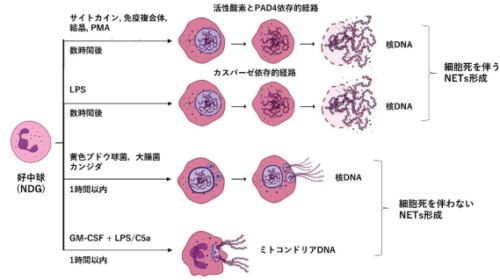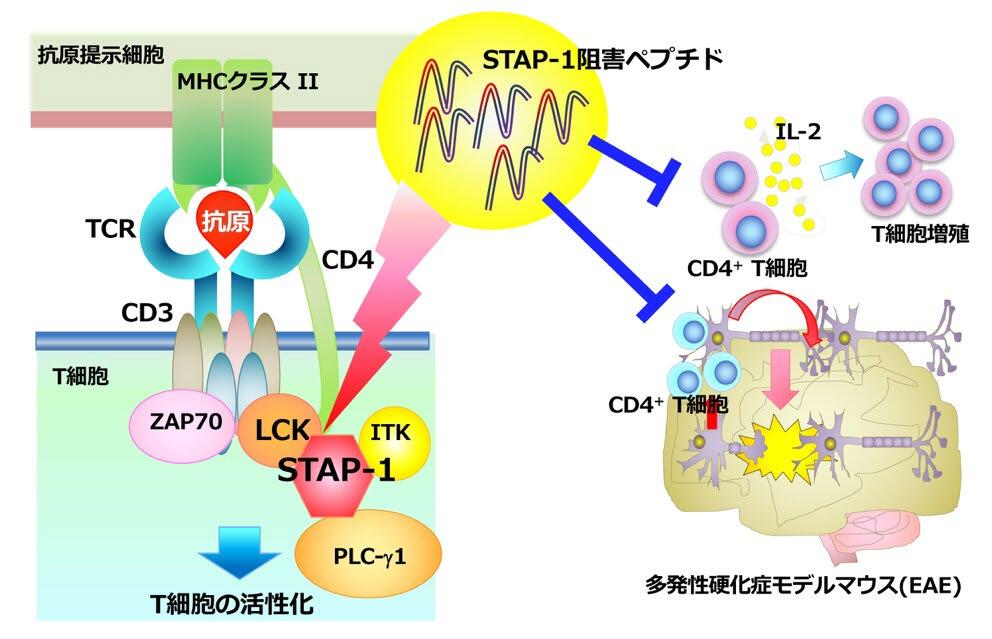2025-05-01 北海道大学

図 1. 多様な好中球細胞外トラップ(NETs)好中球の主要なサブセットである NDG は、各種刺激に応じて、様々な形態の NETs を放出する。その中には、NETs の主成分である DNA が核に由来するものやミトコンドリアに由来するもの、NETs 放出に伴い細胞死に至るものや至らないものがあり、これらの現象を引き起こす経路も多様である。 PMA(phorbol myristate acetate):ホルボールミリステートアセテート LPS(lipopolysaccharide):リポ多糖 GM-CSF(granulocyte-monocyte colony-stimulating factor):顆粒球-単球コロニー刺激因子 C5a(complement 5a):補体 C5a
<関連情報>
- https://www.hokudai.ac.jp/news/2025/05/post-1864.html
- https://www.hokudai.ac.jp/news/pdf/250501_pr.pdf
- https://www.nature.com/articles/s41581-025-00944-3
腎疾患における好中球と好中球細胞外トラップ Neutrophils and NETs in kidney disease
Daigo Nakazawa,Sakiko Masuda,Yuka Nishibata,Kanako Watanabe-Kusunoki,Utano Tomaru & Akihiro Ishizu
Nature Reviews Nephrology Published:18 March 2025
DOI:https://doi.org/10.1038/s41581-025-00944-3
Abstract
Neutrophils, conventionally regarded as a homogeneous immune cell population, have emerged as a heterogeneous group of cells with distinct gene profiles and immune properties. Activated neutrophils release a spectrum of bioactive substances, including cytokines, chemokines, proteolytic enzymes, reactive oxygen species and neutrophil extracellular traps (NETs), which are composed of decondensed DNA and antimicrobial proteins. NETs have a pivotal role in innate immunity, including in preventing the ascent of uropathogenic bacteria into the kidneys, as they efficiently trap pathogenic microorganisms. However, although indispensable for defence against pathogens, NETs also pose risks of self-damage owing to their cytotoxicity, thrombogenicity and autoantigenicity. Accordingly, neutrophils and NETs have been implicated in the pathogenesis of various disorders that affect the kidneys, including acute kidney injury, vasculitis, systemic lupus erythematosus, thrombotic microangiopathy and in various aetiologies of chronic kidney disease. Pathological alterations in the glomerular vascular wall can promote the infiltration of neutrophils, which can cause tissue damage and inflammation through their interactions with kidney-resident cells, including mesangial cells and podocytes, leading to local cell death. Targeting neutrophil activation and NET formation might therefore represent a new therapeutic strategy for these conditions.
Key points
- Neutrophils, the most abundant leukocytes in peripheral blood, become activated in response to various stimuli. Activated neutrophils are involved in several physiological and pathological conditions, including inflammation, immune responses and wound healing.
- Among the biological substances released from activated neutrophils, neutrophil extracellular traps (NETs) are essential to prevent the spread of pathogenic microorganisms. However, excessive NET formation and their impaired degradation can lead to tissue damage, microcirculation disorders and autoantibody production.
- NET formation is not always accompanied by cell death, neutrophil responses to stimuli vary depending on the type of stimulus and the neutrophil subset. In kidney disease, dysregulated NET formation can contribute to chronic inflammation and tissue injury.
- Neutrophils and NETs are involved in the pathogenesis of various kidney diseases and new therapeutic strategies targeting neutrophils and NETs might have a role in the treatment of these conditions.


